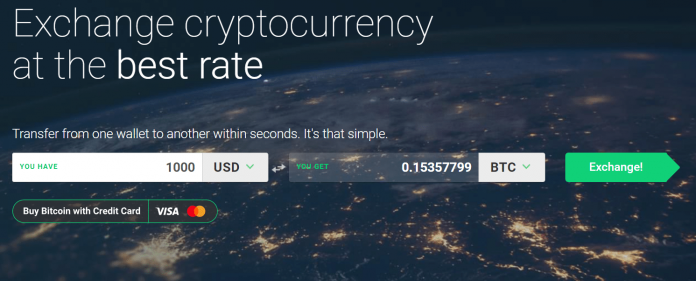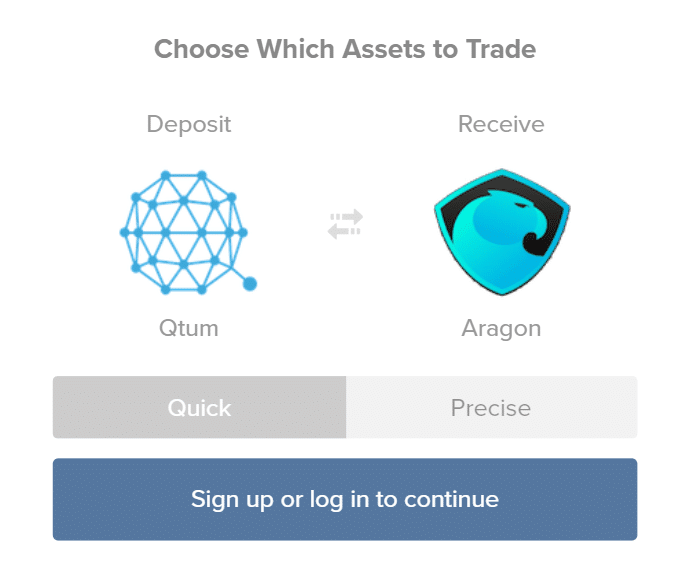
Instant exchanges are a popular way for cryptocurrency traders to trade quickly and efficiently. Many people regard Changelly and ShapeShift as two of the top instant exchange options on the market today. As a cryptocurrency trader, it’s important to consider the pros and cons of any exchange.
In this head-on review, we examine Changelly vs. ShapeShift, considering their key similarities and differences in areas like user interface, security, fees, and currency options.
User Interface
First, in this Changelly vs. ShapeShift comparison, let’s evaluate the user interfaces. This is the first impression that any cryptocurrency trader gets when using an exchange.
Changelly’s interface is quite possibly the most direct, simple-to-use among all cryptocurrency exchanges. For example, instead of having to navigate to a separate page to see trading options and calculate exchange rates, Changelly features this on the top of its homepage. Yes, there is still a signup/login process to go through before actually being able to trade. Nevertheless, you can get a good idea of what fees look like upfront.
The Changelly homepage features a currency conversion calculator that doesn’t require sign-up to use.
Previously, ShapeShift was known as “the exchange without accounts.” However, in September 2018, the exchange decided to change this model in order to protect users and reduce friction. Moving forward, you must create an account in order to trade.
In comparison to Changelly, ShapeShift might be a bit more difficult for newer users. For example, when you go to the exchange homepage, a pop-up says “trading requires an account” and lists all of the potential benefits of using this exchange. When you exit out of the pop-up, you’ll discover a lot of cool features related to exchange statistics. For instance, you can see the most recent transactions of various crypto-to-crypto trades (BTC-to-altcoin, altcoin-to-BTC, and altcoin-to-altcoin). The homepage also features 24-hour statistics for the number of transactions, BTC volume equivalent, average processing time, and most popular trading pair.
Security
Changelly does not store any user funds on its site. Instead, the exchange sends funds directly to your wallet after you use the it. This makes it a non-custodial exchange, which is generally considered to be safer than an exchange which holds cryptocurrency funds (custodial exchange). In addition, Changelly uses two-factor authentication.
In May 2017, one of Changelly’s support accounts got hacked. Some users received a message that read, “All customers exchanging from bitcoin to any currency must make manual transfer to this Bitcoin wallet address:..” Changelly customer support says that they blocked the account in response to prevent users from losing funds.
ShapeShift once used hot wallets on its site. It isn’t clear whether or not this is still the case, but you should be aware of this exchange’s past security vulnerability. In April 2016, ShapeShift was hacked, resulting in the loss of $200,000 in funds. According to CEO Erik Voorhees, the “server infrastructure was compromised and threatened. We made the decision to scrap that infrastructure, and rebuild in a wholly new and safe environment.” It’s important to note that no customer funds were lost. The only funds that were stolen belonged to the company itself. ShapeShift deemed an unnamed employee to be responsible for the incident.
Fees
ShapeShift fees are relatively low for an instant exchange. The exchange only charges a mining fee for each transaction. A few people have said that the exchange makes profits by listing a higher fixed miner fee versus the actual mining fee. Still, ShapeShift fees are typically under 0.5 percent for a given transaction.
The exchange does not refund failed transactions in cases where assets are worth less than the posted miner fee amount. If you send crypto to an incorrect address (i.e. GNT to an ETH address), the exchange will charge an extraction fee equivalent to 50 EUR of the incorrectly sent asset using then-current exchange rates.
Similar to ShapeShift, Changelly fees are set at 0.5%. However, one disadvantage of Changelly is that some people have noted the possibility of hidden fees. For example, if you enter an amount of currency you have (i.e. USD), what you’ll get in another currency (i.e. BTC) isn’t always equal to the current market rate. Sometimes, however, the market rate is accurate. This is something you should be aware of when making a trade to avoid losing funds unnecessarily. While you should always do this with every trade on any exchange, you should be especially proactive in preventing this on Changelly.
Currency Options
Of course, the main advantage of both ShapeShift and Changelly over most exchanges is the fact that there aren’t only a few main coins that make up half of a trading pair. For example, you can easily trade Qtum and Aragon directly, instead of having to trade Qtum to Bitcoin and then Bitcoin to Aragon as you’ll have to do on the vast majority of other exchanges.
If you’re interested in one of the biggest differences in the Changelly vs. ShapeShift debate, fiat currency availability is definitely something to consider. ShapeShift has a strict no-fiat policy. Instead, ShapeShift partnered with Simplex to give you this option. Even with this partnership, you can only choose between BTC-USD and BTC-EUR trading pairs.
There are around 33 cryptocurrencies available on ShapeShift. The site lists several more cryptos as “temporarily unavailable,” which could make the exchange’s usability difficult for some users. In contrast, Changelly offers a variety of crypto trading pairs (more than 90) for USD and EUR. This exchange also allows you to purchase with debit and credit cards (Visa or Mastercard).
Geographic Restrictions and Transaction Limits
Neither ShapeShift nor Changelly have any geographic restrictions. This means that users from around the globe can easily access both of these exchanges. This is good news, especially since numerous exchanges do have such restrictions.
If you’re looking to exchange large amounts of funds, you should know that both exchanges have transaction limits. ShapeShift has a relatively low transaction limit of $10,000 for level 1 users. It’s possible to increase these limits through membership. As of November 2018, higher levels (2-5) for non-members are not yet available. Maximum limits for Changelly include $50 to $10,000 for the first transaction, up to $20,000 per day, and up to $50,000 per month.
Conclusion
So which exchange wins the Changelly vs. ShapeShift debate? By examining the above criteria, it seems that Changelly has a slight edge overall. Although, if fees are important to you, it may be worth using ShapeShift instead.
It’s important to note that ShapeShift added a membership program in September 2018. This will certainly be something to watch out for in the near future as the exchange rolls out these features. It could potentially help improve the overall user experience of ShapeShift. As for Changelly, the exchange continues to announce a number of partnerships with companies in the blockchain and crypto spaces. Things like mobile application integration with various payment apps could very well broaden Changelly’s user base and future adoption as well.
The post Changelly vs. ShapeShift | Head-On Review appeared first on CoinCentral.

Coincentral.com is author of this content, TheBitcoinNews.com is is not responsible for the content of external sites.
Our Social Networks: Facebook Instagram Pinterest Reddit Telegram Twitter Youtube













